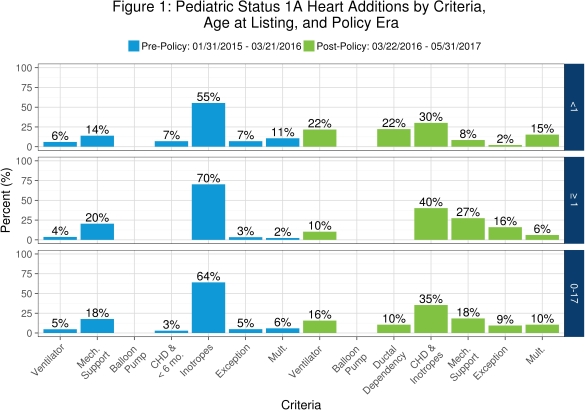Increasing Use of Exceptions after Changes to Pediatric Heart Allocation
1United Network for Organ Sharing, Richmond, VA
2Children's Healthcare of Atlanta, Atlanta, GA
3Children's Medical Center of Dallas, Dallas, TX.
Meeting: 2018 American Transplant Congress
Abstract number: 259
Session Information
Session Name: Concurrent Session: Location, Location, Allocation in Heart Transplantation
Session Type: Concurrent Session
Date: Monday, June 4, 2018
Session Time: 2:30pm-4:00pm
 Presentation Time: 3:42pm-3:54pm
Presentation Time: 3:42pm-3:54pm
Location: Room 4C-3
Purpose: Pediatric heart allocation in the United States was changed in 2016. The primary goal was to better align candidate status with waitlist mortality. Whether the implemented changes have accomplished that goal has not been evaluated.
Methods: We reviewed OPTN data as of 8/2017. Waitlist candidates were divided into two groups based on listing date: Pre-Policy 1/31/2015-3/21/2016; Post-Policy 3/22/2016-5/31/2017. Subgroups divided by age (<1 yr vs. ≥1 yr) and etiology of heart failure. Candidate criteria for listing were compared across groups, including the use of exceptions. Waitlist death and transplant rates were also evaluated.
Results: The percentage of listings at Status 1A declined after the policy changes (72% vs. 54%, p<0.0001) with a corresponding increase in 1B listings (12% vs. 24%). There was a significant increase is number of children listed as 1A by exception (5% to 9%, p=0.0093). Most of the increase in exceptions occurred among patients ≥1 yr of age (3% vs. 16%, p<0.0001) (Figure 1). There was significant regional variation in exception use (range 0% to 20%, p=0.0403). Death rates were lowest among candidates listed by exception (16 deaths/100 pt yrs, 95%CI 2-58) and highest among candidates on a ventilator (110, 95%CI 62-182). Transplant rates increased for 1A candidates with cardiomyopathy, but not for those with other diagnoses (297[95%CI: 260-339] to 387[95%CI: 331-450] transplants/100 pt yrs). This change was more pronounced for children ≥1yr old at listing (293[95%CI: 250-341] to 482[95%CI: 404-571] transplants/100 pt yrs).
Conclusions: Following recent allocation changes, the use of exceptions has increased. Death rates among 1A exception patients are lower than other candidates. These exceptions, predominantly for candidates ≥1 yr old with cardiomyopathy have likely contributed to limiting improvement in transplant rates among other 1A candidates. Modification of behavior regarding exception requests and approvals, and policy changes including a national review board may be necessary to reach the goals of the policy modification.
CITATION INFORMATION: Robinson A., Mahle W., Davies R. Increasing Use of Exceptions after Changes to Pediatric Heart Allocation Am J Transplant. 2017;17 (suppl 3).
To cite this abstract in AMA style:
Robinson A, Mahle W, Davies R. Increasing Use of Exceptions after Changes to Pediatric Heart Allocation [abstract]. https://atcmeetingabstracts.com/abstract/increasing-use-of-exceptions-after-changes-to-pediatric-heart-allocation/. Accessed December 27, 2025.« Back to 2018 American Transplant Congress

